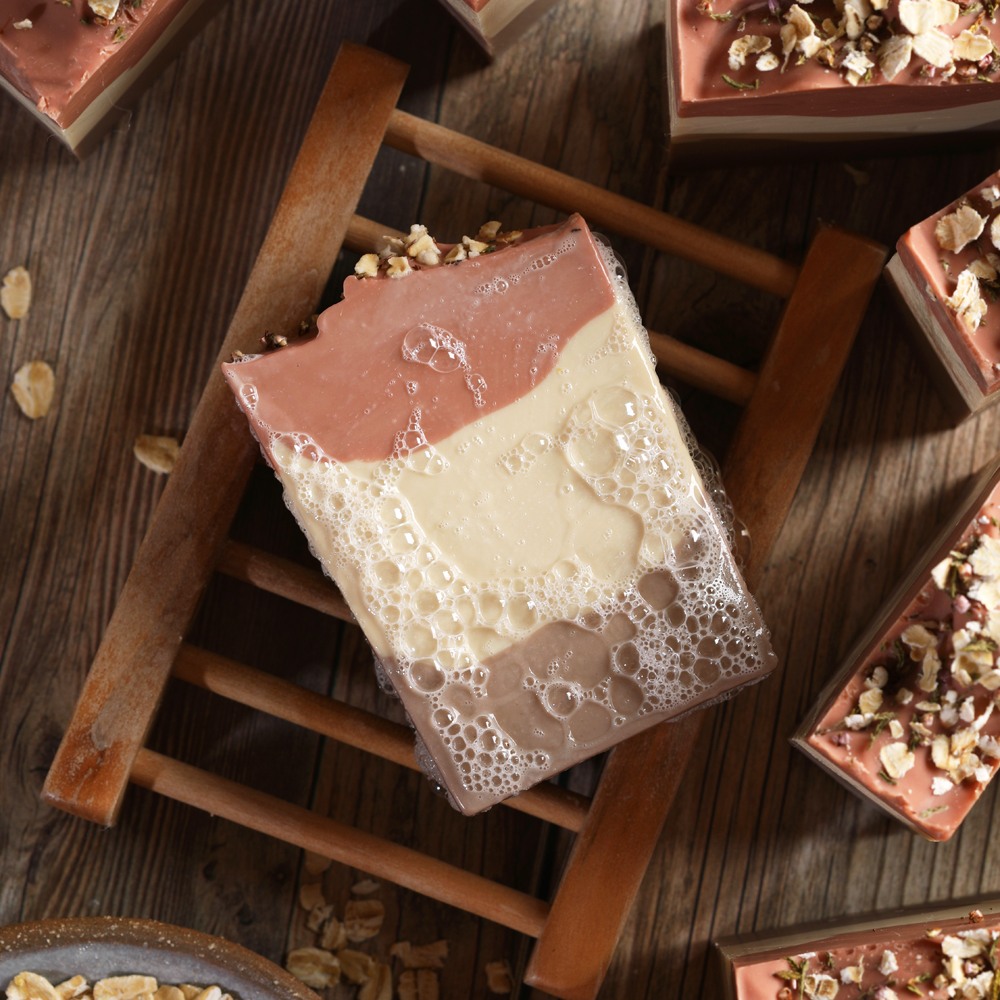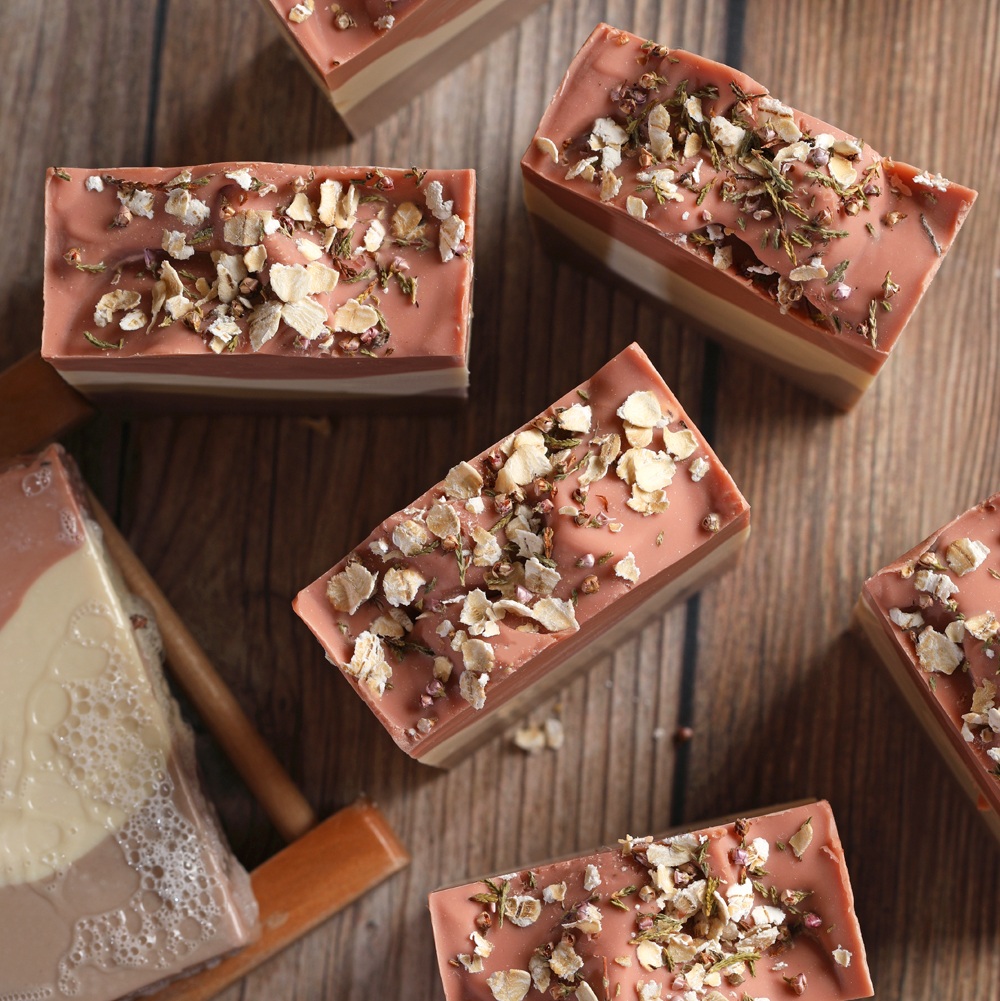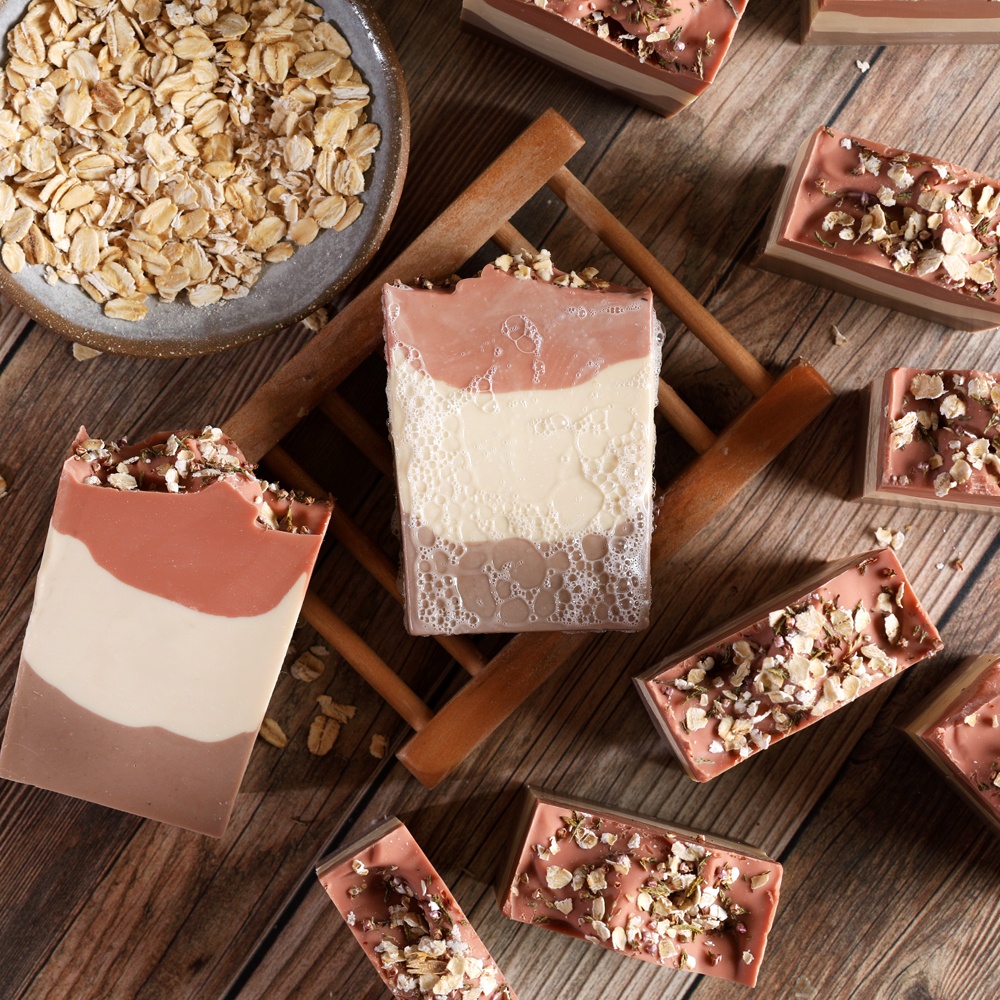
Oat Milk Soap Project
These creamy bars are made with oat milk and natural clays. They're topped with jasmine flowers and oatmeal for a rustic look. Rather than replacing all of the water with oat milk, it's added at trace. This method requires less prep time, and it's a great way to try working with milk for the first time.
For this batch, we used Oatly regular milk, but you can use any brand. We recommend looking for milk with the least amount of added sugar, which can heat the soap and cause scorching, and other additives, which can cause unpredictable results in cold process. Homemade oat milk also works well.
To compensate for the oat milk added at trace, 2 ounces of water are taken from the distilled water that is mixed with lye. Undispersed titanium dioxide is also added to the oils prior to adding the lye water to offset the vanilla discoloration in the Golden Oats Fragrance Oil.
We highly recommend sodium lactate for this batch to help it release easier from the mold. We also recommend placing it in the fridge for at least 6 hours (up to overnight) to prevent scorching.
What You Need:
Recipe
INGREDIENTS:
- Golden Oats Fragrance Oil - 2 oz
- Avocado Butter - 1 lb
- Coconut Oil - 1 lb
- Castor Oil - 1 lb
- Olive Oil - Pure - 1 lb
- Palm Oil - 1 lb
- Sodium Hydroxide Lye
- Sodium Lactate - 4 oz
- Rose Clay - 1 oz
- Alkanet Root Powder - 3 oz
- Titanium Dioxide Pigment - 1 oz
- Jasmine Flowers - 3 oz
EQUIPMENT:
- Tall 12 Silicone Loaf Mold
Instructions
You will need:
- Tall 12″ Silicone Loaf Mold
- 3.4 oz. Avocado Butter (10%)
- 12.9 oz. Olive Oil (38%)
- 0.7 oz. Castor Oil (2%)
- 8.5 oz. Palm Oil (25%)
- 8.5 oz. Coconut Oil (25%)
- 4.8 oz. Sodium Hydroxide Lye
- 8.5 oz. Distilled Water
- 2 tsp. Sodium Lactate
- 2 oz. Oat Milk
- 1.7 oz. Golden Oats Fragrance Oil
- Titanium Dioxide
- Rose Clay
- Alkanet Root Powder
- Jasmine Flowers
- Oatmeal
Note*: This project was originally made with heather flowers and purple Brazilian clay, which have been discontinued. Jasmine flowers and alkanet root powder will create a similar look but may look different than photos and video tutorial.
FRAGRANCE PREP: Measure 1.7 ounces of Golden Oats Fragrance Oil into a small glass container and set aside.
COLORANT PREP: Disperse 1 teaspoon of the titanium dioxide into 1 tablespoons of sunflower or sweet almond oil (or any other liquid oil). In separate containers, mix 1 tablespoon of rose clay and 1 tablespoon of alkanet root powder with 1 tablespoon of distilled water and stir together. Use a mini mixer to get rid of any clumps.
Follow these steps:
1
Slowly and carefully add 4.8 ounces of lye to 8.5 ounces of water and gently stir until the lye has fully dissolved and the liquid is clear. Set aside to cool. Add 2 teaspoons of sodium lactate to help the bars harden more quickly.
2
In a large glass bowl, combine and melt 3.4 ounces of avocado butter, 12.9 ounces of olive oil, 0.7 ounces of castor oil, 8.5 ounces of coconut oil, and 8.5 ounces of palm oil (remember to fully melt then mix your entire container of palm oil before portioning). Add 1 tablespoon of titanium dioxide directly to the oil mixture. This helps get rid of any chunks without thickening trace. Adding it undispersed also prevents adding extra oil.
3
Once the lye water and the oils have cooled to 90-100° F, add the lye water to the oils and stick blend to a very thin trace. Add 2 ounces of oat milk and all the measured 1.7 ounces of Golden Oats Fragrance Oil and whisk in thoroughly.
4
Split the batch evenly into three separate containers. To each, add the following:
- Container A - all dispersed titanium dioxide
- Container B - all dispersed rose clay
- Container C - all dispersed alkanet root powder
Whisk in the colorants thoroughly in each container.
5
If each container is still quite thin, stick blend each from lightest to darkest until it reaches a medium trace. It needs to be thick enough to support a layer on top.
6
Pour all of the purple soap into the mold and tap on the counter to get rid of bubbles. Use a small spoon to evenly spread the soap and create a little bit of texture.
7
Pour or use a spoon to layer all of the white soap on top of the purple. Be careful to not let the soap break through. Use a spoon to evenly spread the soap in the mold, covering the purple soap completely.
8
Pour or spoon all of the pink soap on top of the white. Use a spoon to spread the soap evenly throughout the mold. Tap on the counter to help settle the soap and get rid of air bubbles.
9
Use a small spoon to create texture on top. If it's not holding its shape, give it a few minutes and try again.
10
Top with oatmeal and jasmine flowers until you're happy with the look. Spray with 99% isopropyl alcohol and place into the fridge or freezer for at least 6 hours or up to overnight.
11
Remove from the fridge and let it sit at room temperature for 2 days. To unmold, gently pull the sides of the mold to break the airlock and push out from the bottom. If the airlock does not break easily, give the soap another day in the mold.
12
Once unmolded, lay the loaf on its side and cut into bars. This prevents drag marks.
13
Allow the soap to cure for 4-6 weeks and enjoy!
Tutorial credits
Photographer: Amanda Kerzman

Oat Milk Soap Project
- LEVEL Intermediate
- TIME 2 hours
- YIELD About 3 pounds of soap
Project Description
These creamy bars are made with oat milk and natural clays. They're topped with jasmine flowers and oatmeal for a rustic look. Rather than replacing all of the water with oat milk, it's added at trace. This method requires less prep time, and it's a great way to try working with milk for the first time.
For this batch, we used Oatly regular milk, but you can use any brand. We recommend looking for milk with the least amount of added sugar, which can heat the soap and cause scorching, and other additives, which can cause unpredictable results in cold process. Homemade oat milk also works well.
To compensate for the oat milk added at trace, 2 ounces of water are taken from the distilled water that is mixed with lye. Undispersed titanium dioxide is also added to the oils prior to adding the lye water to offset the vanilla discoloration in the Golden Oats Fragrance Oil.
We highly recommend sodium lactate for this batch to help it release easier from the mold. We also recommend placing it in the fridge for at least 6 hours (up to overnight) to prevent scorching.
You will need:
- Tall 12″ Silicone Loaf Mold
- 3.4 oz. Avocado Butter (10%)
- 12.9 oz. Olive Oil (38%)
- 0.7 oz. Castor Oil (2%)
- 8.5 oz. Palm Oil (25%)
- 8.5 oz. Coconut Oil (25%)
- 4.8 oz. Sodium Hydroxide Lye
- 8.5 oz. Distilled Water
- 2 tsp. Sodium Lactate
- 2 oz. Oat Milk
- 1.7 oz. Golden Oats Fragrance Oil
- Titanium Dioxide
- Rose Clay
- Alkanet Root Powder
- Jasmine Flowers
- Oatmeal
Note*: This project was originally made with heather flowers and purple Brazilian clay, which have been discontinued. Jasmine flowers and alkanet root powder will create a similar look but may look different than photos and video tutorial.
FRAGRANCE PREP: Measure 1.7 ounces of Golden Oats Fragrance Oil into a small glass container and set aside.
COLORANT PREP: Disperse 1 teaspoon of the titanium dioxide into 1 tablespoons of sunflower or sweet almond oil (or any other liquid oil). In separate containers, mix 1 tablespoon of rose clay and 1 tablespoon of alkanet root powder with 1 tablespoon of distilled water and stir together. Use a mini mixer to get rid of any clumps.
Follow these steps:
1
Slowly and carefully add 4.8 ounces of lye to 8.5 ounces of water and gently stir until the lye has fully dissolved and the liquid is clear. Set aside to cool. Add 2 teaspoons of sodium lactate to help the bars harden more quickly.
2
In a large glass bowl, combine and melt 3.4 ounces of avocado butter, 12.9 ounces of olive oil, 0.7 ounces of castor oil, 8.5 ounces of coconut oil, and 8.5 ounces of palm oil (remember to fully melt then mix your entire container of palm oil before portioning). Add 1 tablespoon of titanium dioxide directly to the oil mixture. This helps get rid of any chunks without thickening trace. Adding it undispersed also prevents adding extra oil.
3
Once the lye water and the oils have cooled to 90-100° F, add the lye water to the oils and stick blend to a very thin trace. Add 2 ounces of oat milk and all the measured 1.7 ounces of Golden Oats Fragrance Oil and whisk in thoroughly.
4
Split the batch evenly into three separate containers. To each, add the following:
- Container A - all dispersed titanium dioxide
- Container B - all dispersed rose clay
- Container C - all dispersed alkanet root powder
Whisk in the colorants thoroughly in each container.
5
If each container is still quite thin, stick blend each from lightest to darkest until it reaches a medium trace. It needs to be thick enough to support a layer on top.
6
Pour all of the purple soap into the mold and tap on the counter to get rid of bubbles. Use a small spoon to evenly spread the soap and create a little bit of texture.
7
Pour or use a spoon to layer all of the white soap on top of the purple. Be careful to not let the soap break through. Use a spoon to evenly spread the soap in the mold, covering the purple soap completely.
8
Pour or spoon all of the pink soap on top of the white. Use a spoon to spread the soap evenly throughout the mold. Tap on the counter to help settle the soap and get rid of air bubbles.
9
Use a small spoon to create texture on top. If it's not holding its shape, give it a few minutes and try again.
10
Top with oatmeal and jasmine flowers until you're happy with the look. Spray with 99% isopropyl alcohol and place into the fridge or freezer for at least 6 hours or up to overnight.
11
Remove from the fridge and let it sit at room temperature for 2 days. To unmold, gently pull the sides of the mold to break the airlock and push out from the bottom. If the airlock does not break easily, give the soap another day in the mold.
12
Once unmolded, lay the loaf on its side and cut into bars. This prevents drag marks.
13
Allow the soap to cure for 4-6 weeks and enjoy!
Tutorial credits
Photographer: Amanda Kerzman















